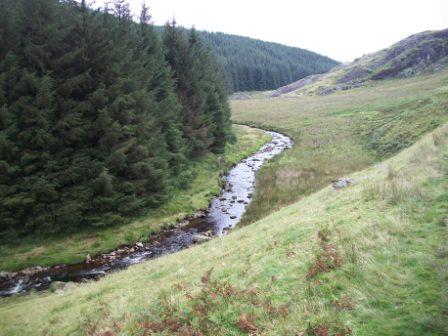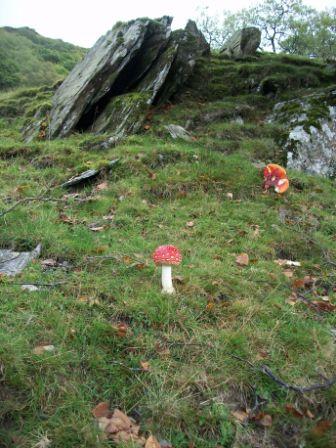Storyman
September 2
We drove to the far end of Abergwesyn Common, out to the west, in the Cambrian mountains. It is a precipitous drive along a narrow track of road. Finally we parked near the last bridge over the Irfon River, a very modest little affair, and took the footpath indicated by an ancient sign covered in lichen. After a brief passage beside the river in open country it rises up into a forestry plantation. Very dark and mysterious, particularly where the mosses dripped from the branches. A single sycamore tree clings on in the midst of monstrous conifers and, here and there troops of russula brighten the darkness with their bright yellow caps.
Then we emerged into a moorland landscape underneath the 'rock of the birds' (Carreg yr Adar). Up ahead the grey willowy shape of a male Hen Harrier disappears behind the rock and looking down at the Irfon, which is now an energetic stream, I see a Dipper skipping up between its rocks. It is a beautiful place and finding a flat rock on which to sit we enjoy its spacious peacefulness, taking photographs and celebrating our good fortune. For now this is as far as my body will carry me up into the far reaches of the Irfon, perhaps at a later date I will have the strength to climb the rocks and penetrate further into the wilderness.

September 5
The river at Llangammarch is a churning brown torrent. The rain has swept off the hills and everything is transformed, no little banks of shingle, no eddying rockpools just swirling mud-brown water from bank to bank.
September 6
The river is still full but the colour has changed from mud brown to river green. But the quantity and speed of water remains dramatic, overhanging branches droop down into the torrent and the paddling mallards, bobbing dippers and busy treecreepers have all disappeared.
September 9
We stopped off for a walk at the Riverside Park in Builth and happened on the confluence of the Irfon with the River Wye. It is a sedate place compared to the tumbling waters in the mountains, a manicured garden with horse chestnut trees and benches. The Irfon marks the end of the park and beyond it is pasture land where four young men stood in the middle of a field intent on a mysterious activity whose purpose was entirely opaque. We walked as far as a crab apple tree with hard, green, bitter fruit where we sat on a small cliff above the river before returning to the car park.
September 14
A warm day in Llangammarch. The river continues to subside, the shingle beaches are beginning to emerge once more and the pace of water has slackened. I found a sheltered spot under the bank and spent a tranquil few minutes watching a few small fish jumping, but there was no birdlife observable. I am missing my Dipper.
September 21
The weather has been wet and I haven't got
out much, but I have found myself reflecting on these past few weeks by the
banks of the Irfon. This has been prompted by reading the reflections of Belden
Lane in his book The Solace of Fierce
Landscapes which reflects on the spiritual life in the context of his
mother's death from cancer and his own love of desert landscape. He talks about
how landscapes don't have an objective meaning, but as we bring ourselves into
them, carrying ourselves, our history and our expectations they speak to us in
specific ways. So how does the landscape of the Irfon River System speak to me
in the context of all that I bring to it? I speak of river system rather than
just river because the landscape is very much not about one main river but also
the many tributaries which flow into it, like for instance the Cammarch which
flows beneath our lounge window and stretches up through Beulah into the same
mountains from which the Irfon comes. All these rivers indicate, of course, that
it is a very wet landscape -- Llangammarch is sometimes called the piss-pot of
Wales! Although how it's annual rainfall compares to other parts of Wales I
don't know. The rain makes the landscape very green but it is pasture land
rather than arable because of the thinness and acidity of the soil. I have seen
few crops being grown. The dampness is, however, a problem for me as our house
appears to have serious damp problems in an extension and this is not good for
my health.
So the landscape is characterized by dampness. Moss grows on our roof and tumbles down into the gutters, clogging the down pipe. The water is also powerful and strong as it surges down the rivers and streams with noisy force. It does not linger but presses on urgently towards the sea. There is energy and activity here, it is no Arcadian idyll but it is also remote and fiercely local. It is part of the modern world but also distant from it. It is Welsh but strongly attached to England -- the local nonconformist minister is a fervent Hereford City supporter! It is also variegated. The uplands of Abergwesyn are quiet and still, patrolled by the sleek grace of the Hen Harrier. Llanwrtyd an energetic village-town of quiet retirement and eccentric activity. Llangammarch a working village filled with fluid flocks of sheep and the rattle of tractor and truck. And there are the quiet settlements like Cefn Gorwydd clustered around its Methodist chapel and Garth and Beulah strung along the A483. Singular farms are spread over the greenness. Churches and chapels stand alone in the fields and there is a railway line clattering along the banks of the river. And through it all the busy dipper works the river, diving into the fast waters to feed his family and build a nest under the shadow of a damp bridge.
September 23

Another trip up to Abergwesyn. This time we stopped by the Oak Forest (Coed Clawdd-coch), which, apparently is the one of the highest oak forests in Britain. We dropped down to the river, picking our way on a sheep path. There are lots of gorgeous little places, pools shaded by trees, cataracts of water gushing through huge rocks, but it is all very boggy with a squishy mat of mosses underfoot. We tried to cross, with the idea of climbing up to a waterfall at Nant Bys but the river was too strong and there was nowhere obvious where we could get across. So we cut back up to the forest and were greeted by a troop of Fly Agaric on the hillside

September 28
A very warm day. Like Midsummer. The air alive with insects and the riverside path deserted. The river is still full, but the banks and beaches are beginning to reappear. I saw the Dipper standing on a stone just beneath my feet, before he flew off upriver. His fast direct flight made me think that what I thought was a Kingfisher a couple of weeks ago was probably the Dipper. He is a very common sight here. Strange after so many hours walking by Welsh rivers and never catching a glimpse, but my eyes are atuned to him now and I'm becoming familiar with the stones and shallow beaches he prefers. At the start of my walk I heard a rushing and splashing but saw nothing and thought it must be Mallard but walking on further I glimpsed through the trees a large bird on the water and the same rushing and splashing as I drove him further downstream. I didn't get much of the sight, but enough to think that it was a Goosander and checking with the book when I got home confirmed my feeling. A female Goosander. I was drawn up the river with the hope of getting a better sight and I walked as far as the old bath house which dates from the time when Llangammarch was a spa town. It is now a ruin, sitting on the bank above a still, dark pool of water. I sat there for some time after picking her way through the brambles and there was a great commotion in the tree opposite I wasn't sure whether it was crows or squirrels but eventually a bright-feathered Jay flew out.
September 30
Piercing blue sky. The air hot and heavy with insects. Tomorrow the record October temperature for Wales will be recorded. We decided to go to Pwll Bo where there is a woodland walk beside the Irfon before it emerges out of the mountains. It was idyllic. Sparkling water, sunlight playing through the trees and subtly shifting landscape. We came out onto a riverside meadow where a small flock of sheep huddled together and above two ravens twisted in the air. I kept a careful eye on the river looking for dippers but no sign of them.